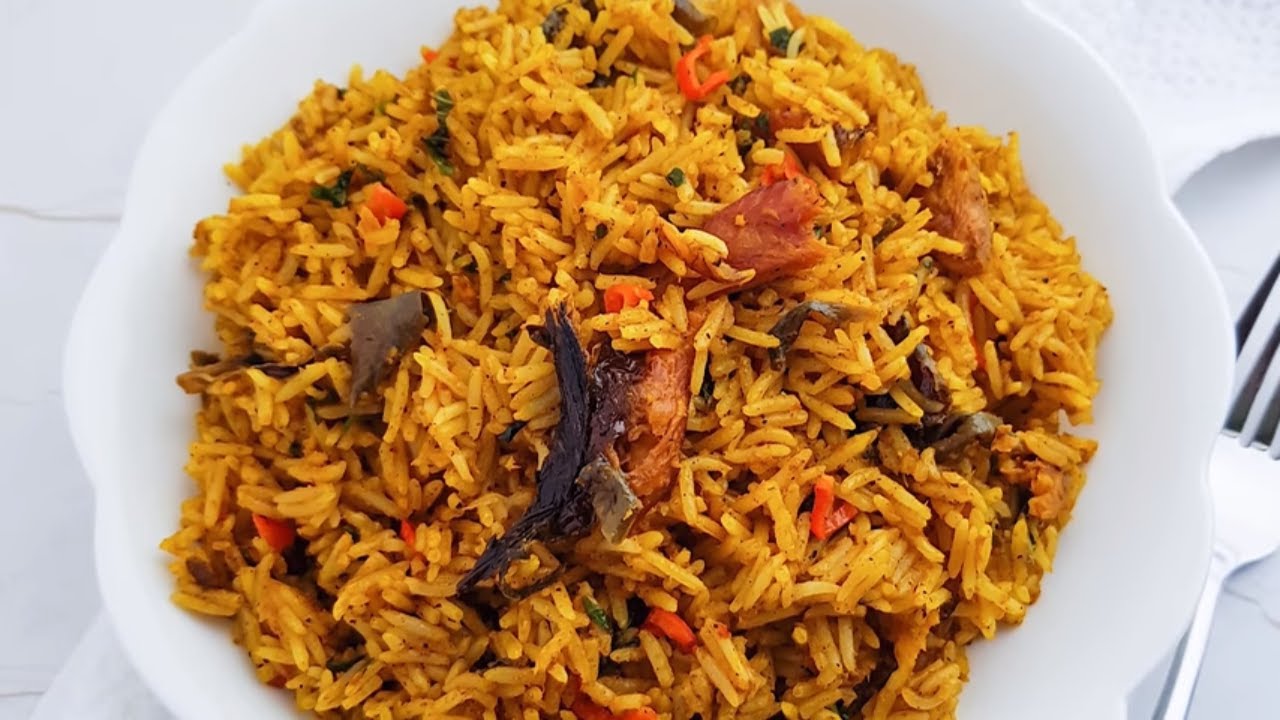Nigerian Food
How To Prepare Nigerian Banga Rice
How To Prepare Nigerian Banga Rice
Contents
Banga stew, also known as “Ofe akwu” in the Igbo language is stew made from palm oil sludge. When my friend told me about Banga rice, I was curious as to how she would cook it and what the outcome would be. I’ll be honest, I had my doubts. However, when she was done cooking, I had a taste and loved everything about it, from the native spicy taste to the unforgettable palm oil after taste. I also hear it is often called native jollof rice. Little wonder, how it was a major delicacy served at a friend’s traditional wedding in Delta state. For the record, the Niger-Deltans are the ones mostly known for this amazing delicacy.
The next time I wanted to cook rice, I decided to try my hand at Banga rice. Its follows the same procedures through which regular jollof rice is made, with only a few tweaks in technique. The ingredients for this meal can be easily found in the market, but if you are in markets outside the eastern part of Nigeria, you have to look for the Igbo/delta women food sellers. They would know what to give you for the best results. One ingredient you may find challenging to get is fresh Banga nuts or palm nuts. However, if you can’t lay your hands on it, you can use fresh palm oil.
Banga Rice Recipe Ingredients
To cook Banga Rice, you would need;
- 1 bowl of Banga nuts or 2 serving spoons of fresh palm oil
- 2 smoked fishes (Medium)
- 2 cow skin or kpomo
- 500kg of beef
- 1 bunch of pumpkin leaves (Optional)
- 2 spoons of black pepper
- 2 tablespoons of crayfish
- 3 cubes of Maggi crayfish or any seasoning cube of your choice
- 4 cups of rice
- 1 tablespoon of Banga soup spice.
- Onions
How to Prepare Banga Rice
- If you are using fresh Banga nuts, it might take a longer time to prepare this delicacy because you have to extract the palm oil from the nuts by boiling them in hot water. When it is soft enough, put them in a mortar and pound till the skin of the nuts pull out from the nuts themselves. When you have achieved this, pour the pounded nuts in a sieve and add slightly hot water, wash the nut till the sludge comes out completely. You have to be very careful doing this, as too much water would make it too watery. So try as much as possible to use little water.
- When you have extracted the juice, keep aside, and work on the proteins. Wash and season the beef with half a teaspoon of salt, one Maggi crayfish cube, onions, and pepper. Cook it until it is soft. Then wash and debone the smoked fish. For the cow skin, make sure to select the soft ones in the market. Wash properly and dice into bits. Include the fish and the cow skin into the pot of boiling beef and let it cook for 10 minutes.
- For your rice, wash it properly until it is rid of the starch and the water almost transparent. Put in a sieve and drain thoroughly.
- In a new pot, pour in the Banga nuts extract and cook for 10 minutes. Afterward, add the spices: crayfish, pepper, salt, Maggi crayfish cubes, salt, and Banga stew spice. The Banga stew spice helps intensify the taste of the Banga nuts extract. Also, put the beef broth or stock (water from cooking the beef) and let it simmer.
- After 15 minutes, add the washed rice and cover the pot. Be very cautious about the water drying up, so top up once you notice it drying up.
- While the rice is cooking, use this time to wash your pumpkin leaves and dice them. Then set aside. This is optional anyway. If you love vegetables like me, you should include this. It gives the rice a unique taste and increases nutrient levels in your meal.
- At this point, the rice should be well cooked so that you can add the beef, fish and diced cow skin. Stir properly. Then put in the diced pumpkin leaves, cover the pot and cook for another 5 minutes.
- Stir one more time and serve.
Chef’s Recommendation
For those using just fresh palm oil, you would find your cooking time shorter than using the Banga nuts because all you have to do is pour in the palm oil and generally cook as though you were cooking jollof rice only in this case, vegetable oil is replaced with palm oil.
Bon Appetit!!!

